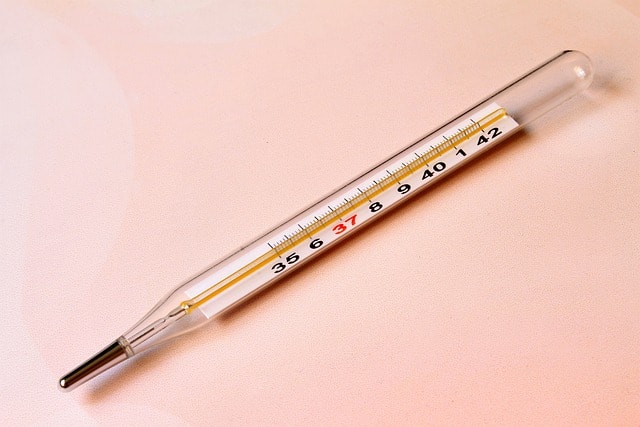Fever in Dogs: Everything You Need to Know
Fever in dogs can be a serious sign that your four-legged friend has health problems. When does a dog have a fever?
This question is crucial because fever can indicate an illness that should be treated immediately. Illnesses such as infections or inflammation often lead to an increased body temperature. Animals such as dogs are sensitive to changes in temperature, so as a dog owner it is important to recognize early on whether your dog has a fever, understand the causes and know what measures you should take.
In this comprehensive guide, you will learn everything you need to know about fever in dogs so that you can react correctly in an emergency and provide your four-legged friend with the best possible support.

What is fever in dogs and why does it occur?
Fever in dogs is a natural reaction of the body to infections, injuries or other health disorders. It is an increase in body temperature that is controlled by the brain - more specifically the hypothalamus - to help the dog's body fight off pathogens.
The normal body temperature in dogs is between 37.5 and 39 degrees Celsius. If the temperature rises above 39 degrees, the dog is said to have a fever. The organism tries to use the increased temperature to kill bacteria, viruses or other harmful microorganisms, since many of these pathogens survive less well or multiply more slowly at higher temperatures.
What symptoms indicate fever in dogs?
Fever is not always easy to recognize in dogs because they often hide their symptoms or we misinterpret them. However, there are some typical signs that may indicate that your dog has a fever:
-
Fatigue and lethargy: Your dog seems tired, has little energy and shows less interest in playing or going for walks.
-
Loss of appetite: Fever can cause your dog to refuse food or eat very little.
-
Increased drinking or refusal to drink: Some dogs drink unusually much when they have a fever, while others may stop drinking altogether.
-
Dry and hot nose: A dry and hot nose is often an early sign of fever, but should not be used as an indicator alone.
-
Glassy eyes: Fever can cause your dog's eyes to appear cloudy and glassy.
-
Chills or shaking: If the body temperature rises sharply, your dog may start to shiver as if he were cold.
-
Increased heart rate and respiratory rate: Fever often causes the heart and respiratory rate to increase.
-
Sweating on the paws: Dogs don't sweat like humans, but release heat through their paws. Wet paws can be another sign of fever.
Although some of these symptoms indicate fever, it is important to check your dog's body temperature to be sure.

How do you correctly measure your dog's body temperature?
To determine for sure whether your dog has a fever, it is not enough to just look at external signs. The most reliable way to detect fever in dogs is to have their temperature measured regularly. This often raises the question: when do we actually speak of fever?
The normal temperature for dogs is between 37.5 and 39 degrees Celsius. The only reliable way to determine this is to measure the temperature with a thermometer. It is best to use a digital thermometer that you apply rectally, as this gives the most accurate results. Although this may seem a little uncomfortable for you and your dog, it is the quickest and safest method.
Step-by-step instructions for measuring a dog’s temperature:
-
Preparation: Take a digital thermometer and some Vaseline or lubricant. The thermometer should be clean and disinfected.
-
Keep Calm: Make sure your dog is standing or lying still. It is best to have a second person help you by holding your dog's head and calming him down.
-
Insert thermometer: Moisten the thermometer with Vaseline and carefully insert it about 2 to 3 centimeters into your dog's anus. Make sure that your dog remains relaxed.
-
Wait for measurement: Wait until the thermometer beeps. This usually only takes a few seconds.
-
Read the result: If the temperature is above 39 degrees Celsius, your dog has a fever.

Normal body temperature in dogs: What is considered a fever?
The normal body temperature of a healthy dog is usually between 37.5 and 39 degrees Celsius. However, this temperature can vary slightly depending on the breed, age and activity level. In puppies, the body temperature may tend to be slightly higher, while in older dogs it may be lower.
Fever begins when the body temperature rises above 39 degrees. A reading above 41 degrees is a medical emergency and requires immediate veterinary attention, as this temperature can lead to organ damage or even death.
Causes of fever in dogs: What are the reasons?
There are many different causes that can cause fever in dogs. Often it is a sign that your dog's body is fighting an infection or inflammation. The most common causes include:
-
Infections: Bacterial, viral or fungal infections are one of the most common causes of fever. These infections can affect different parts of the body, such as the respiratory tract, ears, teeth or skin.
-
Injuries and wounds: Open wounds or post-operative inflammation can also cause fever. If a wound becomes infected, the body reacts with an increased temperature.
-
Autoimmune diseases: In autoimmune diseases, the dog's immune system attacks its own cells, which can result in inflammation and fever.
-
Poisoning: If your dog has eaten something poisonous or has come into contact with a toxic substance, his body may react with a fever to fight the toxins.
-
Heatstroke: Especially in the hot summer months, there is a risk of heat stroke if your dog stays in the sun or in high temperatures for too long. Heat stroke leads to a dangerous increase in body temperature, which can be life-threatening.
When should you as a dog owner take your dog to the vet?
Fever is a warning sign that you should not ignore. In many cases, it is enough to observe your dog and give him rest and fluids. However, if the fever lasts longer than a day or the temperature rises above 39.5 degrees, you should definitely see a veterinarian.
You should also act quickly if additional symptoms such as vomiting, diarrhea, shortness of breath or seizures occur. A veterinarian can determine the exact cause of the fever and initiate the appropriate treatment.
First aid for fever: What can you do?
If you notice that your dog has a fever, it is important to help him immediately to minimize the stress on his body. Here are some tips on how you can help your dog:
Skåne: Let your dog rest and avoid physical exertion. Rest helps your dog to recover faster.

Sufficient fluid: Make sure your dog drinks enough. Fever leads to increased fluid loss, which you should compensate for. Always offer him fresh water.

Cool environment: Keep your dog in a cool, shady place, especially if the fever is caused by heat or heat stroke. You can also place a damp cloth on his paws to cool him down slightly.
No human medications: Never give your dog fever-reducing medications for humans, such as paracetamol or ibuprofen. These are toxic to dogs and can cause serious side effects. Always consult a veterinarian before giving your dog any medication.
Preventing fever: What can you do?
In many cases, fever cannot be completely avoided as it is a natural response of the body to infections. However, there are some steps you can take to reduce the risk of your dog getting a fever:
-
Regular vaccinations: Keep your dog's vaccinations up to date to protect him from contagious diseases.
-
Deworming and parasite prophylaxis: Protect your dog regularly from parasites such as fleas, ticks and worms, which can cause infections.
-
Healthy eating: A balanced and high-quality diet strengthens your dog's immune system and helps him to fight diseases better.
-
Sufficient exercise: Regular exercise keeps your dog fit and strengthens his immune system.
-
Avoid stress: Stress can weaken the immune system, so try to minimize stressful situations for your dog and provide him with a safe and relaxed environment.
Home remedies for fever in dogs: What can help?
There are some home remedies that can help relieve your dog's fever. However, these home remedies are not an alternative to veterinary treatment and should only be used as a supplement:
Wet wipes: You can place damp, cool towels on your dog's paws to gently lower his body temperature.
Lukewarm water for drinking: Offer your dog lukewarm water, which is easier for him to drink and can also regulate his body temperature.
Lots of rest and sleep: Let your dog rest in a quiet environment so that his body can recover better.
How long does a dog have a fever?
The duration of the fever depends on the cause. Infections or inflammation can cause your dog to have a fever for one to two days. However, if the fever lasts longer than two to three days or the temperature rises sharply, it is advisable to see a veterinarian immediately. A persistent or high fever can indicate more serious problems that require medical treatment.
Febrile cramps in dogs: What should you do?
In rare cases, high fever can cause febrile seizures in dogs. These can be characterized by shaking, muscle twitching, or loss of consciousness. A febrile seizure can be very frightening, but it is important to remain calm. Make sure your dog does not injure himself during the seizure by keeping him away from dangerous objects. After a febrile seizure, you should see a vet immediately, as this can be a serious health problem.
Difference between fever and hyperthermia in dogs: What should you know?
It is important to distinguish between fever and hyperthermia. Fever is a controlled increase in body temperature, which is controlled by the body itself in order to fight pathogens. Hyperthermia, on the other hand, is caused by external influences, such as high ambient temperatures or physical overexertion. While fever is a reaction to an infection or inflammation, hyperthermia can be triggered by heat stroke, for example. In both cases, quick action is required, but the treatments differ.
When is fever life-threatening in dogs?
Fever becomes dangerous when it gets very high or lasts for a long period of time. Temperatures above 41 degrees Celsius are considered life-threatening because they can lead to organ damage, circulatory failure or heat stroke. A dog with such a high fever needs immediate veterinary help to avoid serious health consequences. If your dog shows symptoms such as bloody diarrhea, vomiting, shortness of breath or severe tremors in addition to fever, you should also seek emergency veterinary attention.
How does the immune system support your dog when he has a fever?
Your dog's immune system plays a crucial role when it comes to fever. Fever is the body's natural reaction to pathogens such as viruses or bacteria. The increased body temperature inhibits the proliferation of these pathogens and gives the immune system a better chance of fighting the infection. Nevertheless, an overactive immune system can also cause damage if it reacts too long or too strongly. That's why it's important to monitor the fever and seek veterinary help if necessary.
Can fever go away on its own?
In many cases, the fever goes away on its own once the body has successfully fought off the cause, such as a mild infection. This can happen within one to two days. During this time, you should take it easy on your dog, give him plenty of rest and make sure he drinks enough.
If your dog's condition does not improve after a few days or the fever continues to rise, you should definitely seek veterinary advice.
What to do after a dog has a fever?
After your dog has recovered from a period of fever, it is important to continue to support his recovery. Offer him easily digestible food that does not burden his stomach. Sufficient fluids are also crucial to compensate for the fluid loss caused by the fever. You should also slowly introduce him to walks and physical activities again, but only when he has fully recovered. Avoid putting your dog under too much strain straight away so that his immune system can fully regenerate.
Conclusion on fever in dogs
Fever in dogs is a serious warning sign that you should never ignore. It can have many causes, from infections to heat stroke, and requires careful observation and, if necessary, veterinary treatment. However, with the right knowledge and the right measures, you can help your dog and ensure that he gets well again quickly.
